 W
WThe Poeciliidae are a family of freshwater fishes of the order Cyprinodontiformes, the tooth-carps, and include well-known live-bearing aquarium fish, such as the guppy, molly, platy, and swordtail. The original distribution of the family was the southeastern United States to north of Río de la Plata, Argentina, and Africa, including Madagascar. However, due to release of aquarium specimens and the widespread use of species of the genera Poecilia and Gambusia for mosquito control, poeciliids can today be found in all tropical and subtropical areas of the world. In addition, Poecilia and Gambusia specimens have been identified in hot springs pools as far north as Banff, Alberta.
 W
WAlfaro is a genus of poeciliid fishes endemic to Central America. The generic name honours the Costa Rican archaeologist, geologist, ethnologist, zoologist and Director of the National Museum of Costa Rica, Anastasio Alfaro (1865-1951).
 W
WThe banded lampeye is a species of poeciliid that is native to Africa, ranging from Senegal to Angola. It is mainly found in coastal brackish habitats such as river mouths, lagoons and mangrove swamps. It reaches up to 7 cm (2.8 in) in total length.
 W
WThe barred topminnow is a species of poeciliid fish endemic to Cuba where it prefers patches of aquatic vegetation in ponds. Females grow to a standard length of up to 3.4 cm (1.3 in), while males only reach 2 cm (0.8 in).
 W
WBrachyrhaphis is a genus of poeciliids native to freshwater habitats in Central America. Most are restricted to Panama and Costa Rica, but B. holdridgei also occurs in Nicaragua and B. hartwegi is from Mexico and Guatemala. A recent phylogenetic analysis has suggested that Brachyrhaphis may not be of a monophyletic group.
 W
WCnesterodon is a genus of poeciliids native to South America.
 W
WCnesterodontini is a tribe of fishes which are within the subfamily Poeciliinae of the family Poeciliidae. This tribe is distinguished from other tribes in the Poeciliinae by the males having five rays in the pelvic fin, there is a pedicle at the base of the third ray which joins it to the fourth ray, another pedicle at the third rays tip and a membrane there too.
 W
WThe dusky millions fish, speckled mosquitofish or the one-spot livebearer is a species of fish native eastern and southern Brazil, northern Argentina, Uruguay and Paraguay. It has also been introduced to Australia, Malawi and New Zealand; primarily for mosquito control, but also as escapees from the aquarium trade. It has been reported as having adverse ecological effects in areas where it has been introduced. The females of this species grow to a total length of 6 centimetres (2.4 in), while males remain smaller.
 W
WFluviphylax is a genus of tiny poeciliids native to the Amazon Basin, Orinoco Basin and Oyapock Basin in South America.
 W
WGambusia is a large genus of viviparous fish in the family Poeciliidae. Gambusia contains over 40 species, most of which are principally found in freshwater habitats, though some species may also be found in brackish or saltwater habitats. The type species is the Cuban gambusia, G. punctata. The greatest species richness is in Mexico, Texas, and the Greater Antilles, but species are also found elsewhere in eastern and southern United States, The Bahamas, Central America, and Colombia. Gambusia species are often called topminnows or simply gambusias; they are also known as mosquitofish, which, however, refers more specifically to two species, G. affinis and G. holbrooki. These can be introduced into ponds to eat mosquito larvae. As a consequence, they have been introduced widely outside their native range, and frequently become invasive, threatening the local species. They are only occasionally kept in aquariums, due to their relative lack of color and the highly aggressive nature of the aforementioned mosquitofish species.
 W
WGambusiini, also spelled Gambusini, is a tribe of killifishes from the "livebearer" family Poeciliidae. Their native range encompasses Central and much of North America, with a single species Gambusia lemaitrei occurring in South America. Some species have been widely introduced outside their native range and the Eastern mosquitofish Gambusia holbrooki is considered to be one of the 100 worst invasive species in the world and is responsible for declines in small native aquatic species worldwide.
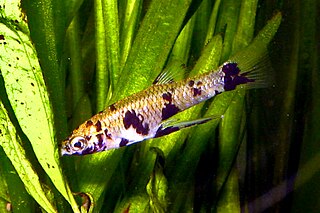 W
WThe Girardini is a tribe of killifishes from the "livebearer" family Poeciliidae, consisting of three genera and 10 species. The tribe was originally delineated by Carl Leavitt Hubbs in 1924.
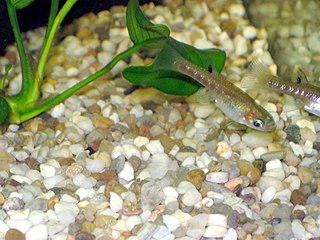 W
WGirardinus is a genus of poeciliids native to Cuba. The name of this genus honours the French zoologist Charles Frédéric Girard (1822-1895) for his work on the freshwater fish of North America.
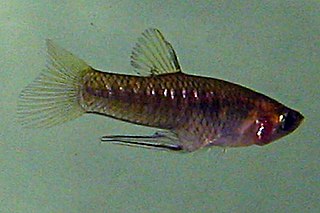 W
WGirardinus metallicus is a species of fish from the family of the Poeciliidae.
 W
WHeterandria is a genus of livebearing fishes within the family Poeciliidae. Most species occur in Guatemala and its surroundings, particularly Mexico, but the midget livebearer (H. formosa) comes from the southeastern United States.
 W
WHeterandria formosa is a species of livebearing fish within the family Poeciliidae. This is the same family that includes familiar aquarium fishes such as guppies and mollies. Heterandria formosa is not as commonly kept in aquaria as these species. H. formosa is one of the smallest fish in the world, and is the smallest fish found in North America. Despite the common name "least killifish", it belongs to the family Poeciliidae and not to one of the killifish families.
 W
WThe Heterandriini is a tribe of killifishes from the "livebearer" family Poeciliidae, consisting of seven genera and around 50 species. The tribe was originally delineated by Carl Leavitt Hubbs in 1924.
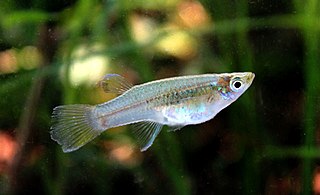 W
WHeterophallus is a genus of small poeciliids found near the coast in calm waters of river basins in southeastern Mexico.
 W
WThe Tanganyika killifish is a species of poeciliid endemic to Lake Tanganyika, where it forms large schools, mainly close to rocky shores but also pelagically off shore. This species grows to a length of 15 centimetres (5.9 in) SL. It is an egglayer with external fertilization, and deposits its eggs in narrow crevices. It is fished commercially for food, and also for the aquarium trade. It has been introduced to Lake Kivu.
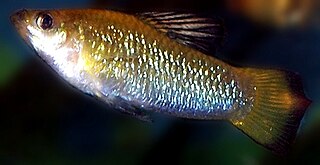 W
WLimia is a genus of livebearing fishes belonging to the Cyprinodontiform family Poeciliidae, which includes other livebearers such as platys, swordtails, guppies and mollies. They are found in fresh and brackish water. Of the 21 described Limia species, 17 are endemic to Hispaniola, one is found on both Hispaniola and Jamaica, and the Cayman Islands, Cuba, and Venezuela have an endemic species each. Limia are popular in aquaria among more advanced hobbyists.
 W
WNeoheterandria is a genus of poeciliids native to Panama and Colombia.
 W
WNeoheterandria elegans or Tiger Teddy is a small live-bearing fish within the family Poeciliidae. This is the same family that includes familiar aquarium fishes such as guppies and swordtails, although Neoheterandria elegans is not nearly as popular as an aquarium fish. The fish is found in the Truando River in Colombia. Males grow to 2.0 centimetres (0.79 in) and females grow to 2.5 centimetres (0.98 in). The front half of the fish is mostly silver but the rear has alternating gold and black vertical bars.
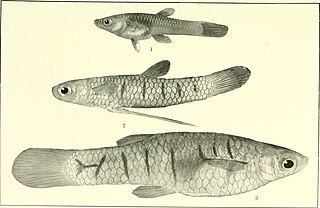 W
WPamphorichthys is a genus of poeciliids native to the Amazon, Paraguay, São Francisco and Itapicuru basins in South America.
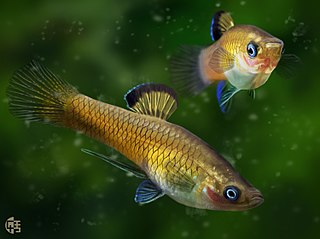 W
WPhallichthys is a genus of poeciliids native to Central America.
 W
WPhalloceros is a genus of poeciliids native to freshwater habitats in Brazil, Paraguay, Uruguay and northern Argentina. The majority are endemic to southern and southeastern Brazil. P. caudimaculatus has long been part of the aquarium industry and has been introduced to countries far from its native range.
 W
WPhalloptychus is a genus of poeciliids native to eastern and southern Brazil, northern Argentina, Paraguay and Uruguay.
 W
WPhallotorynus is a genus of poeciliids native to southern Brazil, northern Argentina, and Paraguay.
 W
WThe pike topminnow, also known as the top minnow, is a species of poeciliid found from Mexico to Costa Rica. It has also been introduced to Florida, USA. The female of the species grows to a length of 20 centimetres (7.9 in) TL, with males growing to a length of 10 centimetres (3.9 in) TL. It is the only known member of its genus. Unlike most poeciliids, this is a highly specialized predator, with an extremely flexible upper jaw that enables them to take very large prey items for their size. The piki topminnow was described in 1860 by the Austrian ichthyologist Rudolf Kner, Kner gave the type locality as Belize, which is reflected in this species specific name.
 W
WPoeciliinae is a subfamily of killifish from the family Poeciliidae which contains species from the Americas which are collectively known as the livebearers because many, but not all, of the species within the subfamily are ovoviviparous.
 W
WThe Poeciliini is a tribe of killifishes from the "livebearer" family Poeciliidae, consisting of six genera and just over 100 species.
 W
WPoeciliopsis is a genus of poeciliid fishes that primarily are native to Mexico and Central America. The only exceptions are P. turrubarensis where the range extends into Colombia, and P. occidentalis where the range extends into Arizona and New Mexico.
 W
WPoropanchax is a genus of small poeciliid fishes native to Africa.
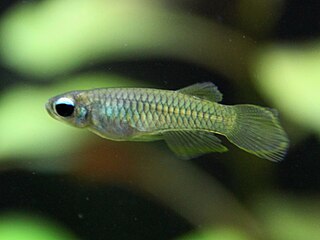 W
WPoropanchax normani, known as the Norman's lampeye, is a species of killifish native to Africa.
 W
WPriapella is a genus of poeciliid fish endemic to fresh water habitats in southern Mexico.
 W
WProcatopodinae is a subfamily of the family Poeciliidae, the "livebearers", in the order Cyprinodontiformes. Some authorities treat this subfamily as a family, the Procatopodidae, including the banded lampeye.
 W
WThe Procatopodini is an African tribe of fishes, it is part of the subfamily Procatopodinae, within the family Poeciliidae.
 W
WPseudopoecilia is a genus of small poeciliid fishes native to rivers, streams, springs, ponds and pools in the Chocó-Tumbes region in southwestern Colombia, western Ecuador and northwestern Peru.
 W
WPseudoxiphophorus is a genus of fish from the family Poeciliidae. The species in the genus were formerly considered to be in the genus Heterandria but workers found that most of the species were not closely related to the type species of that genus, Heterandria formosa, and seven species were transferred to the genus Pseudoxiphophorus. They are found in Central America.
 W
WThe barred topminnow is a species of poeciliid fish endemic to Cuba where it prefers patches of aquatic vegetation in ponds. Females grow to a standard length of up to 3.4 cm (1.3 in), while males only reach 2 cm (0.8 in).
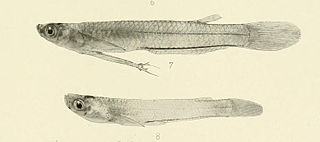 W
WTomeurus gracilis is a species of poeciliid fish native to South America, in Brazil, Surinam and Venezuela. This species grows to a length of 3.3 centimetres (1.3 in) TL. It is the only known member of its genus. This specie sis classified in the tribe Cnesterodontini in the 5th edition of Fishes of the World. but other workers place it in its own tribe, the Tomeurini.
 W
WTomeurus gracilis is a species of poeciliid fish native to South America, in Brazil, Surinam and Venezuela. This species grows to a length of 3.3 centimetres (1.3 in) TL. It is the only known member of its genus. This specie sis classified in the tribe Cnesterodontini in the 5th edition of Fishes of the World. but other workers place it in its own tribe, the Tomeurini.
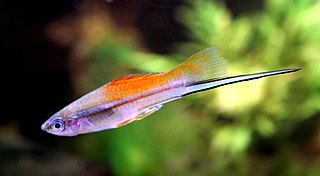 W
WXiphophorus is a genus of euryhaline and freshwater fishes in the family Poeciliidae of order Cyprinodontiformes, native to Mexico and northern Central America. The many Xiphophorus species are all called either platyfish or swordtails. The type species is X. hellerii, the green swordtail. Like most other new world Poeciliids, platies and swordtails are live-bearers that use internal fertilization and give birth to live young instead of laying eggs like the bulk of the world's fishes. The name Xiphophorus derives from the Greek words ξίφος (dagger) and φόρος (bearer), referring to the gonopodium on the males. All are relatively small fishes, which reach a maximum length of 3.5–16 cm (1.4–6.3 in) depending on the exact species involved.